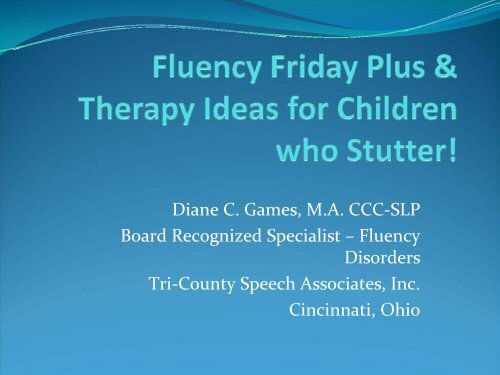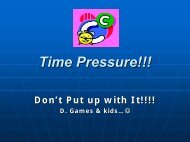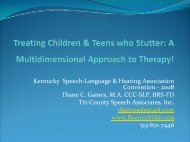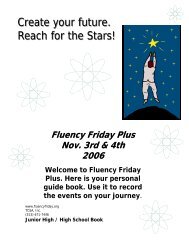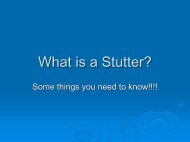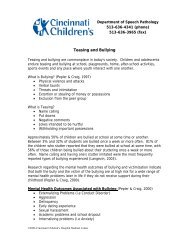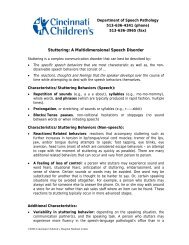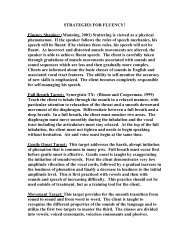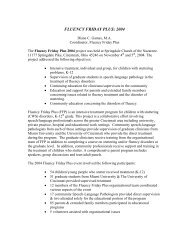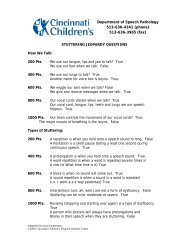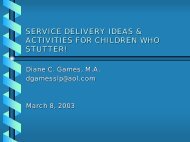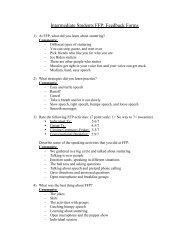Fluency Friday Plus & Therapy Ideas for Children who Stutter!
Fluency Friday Plus & Therapy Ideas for Children who Stutter!
Fluency Friday Plus & Therapy Ideas for Children who Stutter!
Create successful ePaper yourself
Turn your PDF publications into a flip-book with our unique Google optimized e-Paper software.
Diane C. Games, M.A. CCC‐SLP<br />
Board Recognized Specialist – <strong>Fluency</strong><br />
Disorders<br />
Tri‐County Speech Associates, Inc.<br />
Cincinnati, Ohio
<strong>Fluency</strong> <strong>Friday</strong> <strong>Plus</strong>……<br />
• FFP started as an idea in the Spring of 2001.<br />
• I wanted my students <strong>who</strong> stuttered to meet other<br />
kids <strong>who</strong> shared similar fears, hopes and feelings<br />
about stuttering.<br />
• In one hour, I managed to reach several very busy<br />
professionals in the Cincinnati area <strong>who</strong> agreed to<br />
work on this project: Phyllis Breen, Susan Givler, Irv<br />
Wollman, Jim Mallot, Ann Slone and of course my<br />
partner Patty Fisher….
<strong>Fluency</strong> <strong>Friday</strong>…<br />
• <strong>Fluency</strong> <strong>Friday</strong> started in 2001 with 20 children/teens<br />
<strong>who</strong> stuttered and a few parents <strong>who</strong> spent the day<br />
talking and sharing hopes, ideas and in<strong>for</strong>mation.<br />
• The next year, FFP grew to a day and one‐half. Each<br />
year we have continued to grow. FFP‐2007 had 57<br />
children/teens <strong>who</strong> stutter, approximately 60 parents,<br />
45 graduate students from the University of<br />
Cincinnati and Miami University and 18 supervisors.<br />
• Rod Gabel, Derrick Daniels, Donna Cooperman, &<br />
Nina Reardon provided professional support.
Current Leadership includes<br />
• Karen Rizzo, Carie Lewis, Stephanie Jeters, Sue<br />
Schmidlin, Rose Pietrzyk , Ann Slone & Sally<br />
Demmler<br />
• <strong>Plus</strong> many excellent speech‐language pathologists<br />
from the Cincinnati area.<br />
• FFP represents several practice settings:<br />
university, educational, private practice &<br />
hospital.
What are the goals of FFP!<br />
Intensive treatment <strong>for</strong> CWS in both individual and<br />
small group settings.<br />
Supported practicum <strong>for</strong> graduate students to<br />
develop clinical skills.<br />
Parent training/education about stuttering.<br />
Developing ideas and in<strong>for</strong>mation to share with<br />
practicing slps including a manual and a web page<br />
which continue to be updated and expanded.
Why talk about FFP……<br />
• <strong>Ideas</strong> and in<strong>for</strong>mation is available to you ongoing at<br />
www.fluencyfriday.org!!!<br />
• Several of the ideas from FFP will be shared today and<br />
you are invited to come and experience FFP‐2008 (the<br />
first <strong>Friday</strong> and Saturday morning in November!)<br />
• You don’t have to do a project like FFP to impact kids<br />
<strong>who</strong> stutter on your caseload…….you can help these<br />
students connect with each other in some unique<br />
ways!
Some additional thoughts on FFP….<br />
• Ask yourself what is possible.<br />
• Join your professional organizations and get to know<br />
how they can help you.<br />
• Understand your limitations in setting up some<br />
intensive group/individual treatment approaches.<br />
• Don’t be afraid to ask <strong>for</strong> help…..our community of<br />
professionals is awesome!
PowerPoint as a Motivating,<br />
Teaching Tool!<br />
1. <strong>Stutter</strong>ing Treatment needs to include activities<br />
to address Speech Behaviors, Coping Behaviors,<br />
and Reactions to <strong>Stutter</strong>ing.<br />
2. Materials to address feelings and the cognitive<br />
aspects of fluency disorders is needed.<br />
3. Kids/teens are “computer savvy” and love to<br />
learn or engage in this type of presentation.
Development of the slides…<br />
• These presentations have been designed using the<br />
clients’ suggestions <strong>for</strong> wording, important points<br />
and graphics.<br />
• Some of the presentations are concluded using slides<br />
specifically developed by CWS which are shared with<br />
other students on my caseload. This allows sharing of<br />
ideas and thoughts when a group is not possible.
Some Basic Concepts <strong>for</strong> TX<br />
• <strong>Children</strong>/Teens need a vocabulary to talk<br />
about stuttering & to describe what is<br />
happening during a disfluent moment.<br />
• They also need time to think about their<br />
stuttering. Thinking allows them to plan<br />
strategies <strong>for</strong> approaching difficult speaking<br />
situations.
Presentation….<br />
• I will share several power point presentations and talk<br />
about various ideas that have been used successfully<br />
in treating children and teens <strong>who</strong> stutter. These<br />
power point presentations will also include materials<br />
developed <strong>for</strong> the <strong>Fluency</strong> <strong>Friday</strong> <strong>Plus</strong> project.<br />
• These presentations are “working documents” that<br />
are revised periodically as children and teens re‐visit<br />
them and update in<strong>for</strong>mation and ideas.
Power Point treatment allows CWS<br />
to describe behaviors & feelings<br />
concerning stuttering….<br />
• <strong>Children</strong> <strong>who</strong> stutter need a vocabulary to describe<br />
what happens in their speech.<br />
• <strong>Stutter</strong>ing often becomes the “it” factor…i.e. “It<br />
happens when I talk on the phone.”<br />
• When a person can describe a behavior, then<br />
solutions or changes in behavior become manageable.
Power Points are developed..<br />
• By picking a behavior, concept or problem<br />
that students talk about in treatment.<br />
• Defining the behavior/ concept<br />
• Explaining how the behavior impacts<br />
communication<br />
• Describing personal experiences<br />
• Providing suggestions.
Power Point Presentations<br />
• Materials seen in this presentation are available on<br />
www.fluencyfriday.org (<strong>Fluency</strong> <strong>Friday</strong> <strong>Plus</strong>)<br />
• This web site is a product of an intensive treatment<br />
program <strong>for</strong> children/teens <strong>who</strong> stutter developed by<br />
local speech‐language pathologists in the Cincinnati<br />
area to bring children/teens and their families<br />
together to learn more about stuttering. Please feel<br />
free to use the materials to help your students!
Power Point Advantages…….<br />
• Allows <strong>for</strong> Communication between students <strong>who</strong> feel<br />
isolated.<br />
• PP can incorporate a students ideas in a way that validates<br />
their feelings.<br />
• PP can be fun and motivating <strong>for</strong> the child/teen <strong>who</strong><br />
stutters.<br />
• PP as a teaching tool is flexible, can be changed, can be<br />
updated and copies can be sent home <strong>for</strong> further<br />
discussion.<br />
• PP presentations can also deal with specific issues such as<br />
teasing, speech helpers, etc.
Power Point teaching tools<br />
including:<br />
• What is a <strong>Stutter</strong><br />
• Time Pressure in Communication Interactions<br />
• Avoidance<br />
• My Story<br />
• Analogy to Star Wars<br />
• Personal story about teasing.


